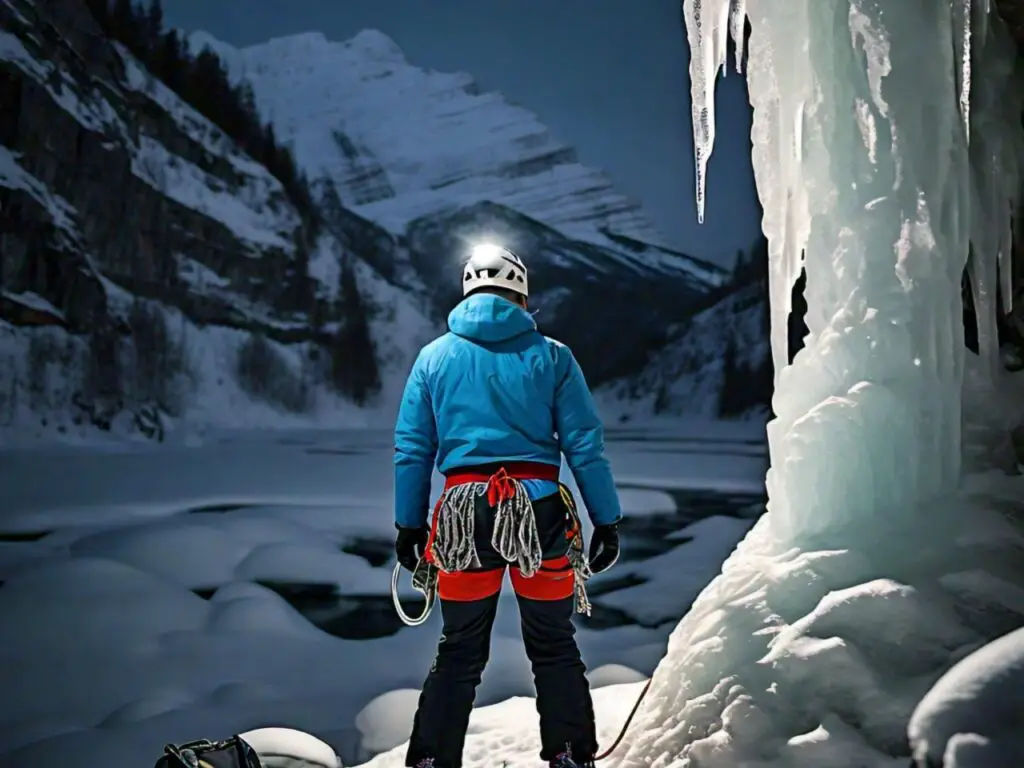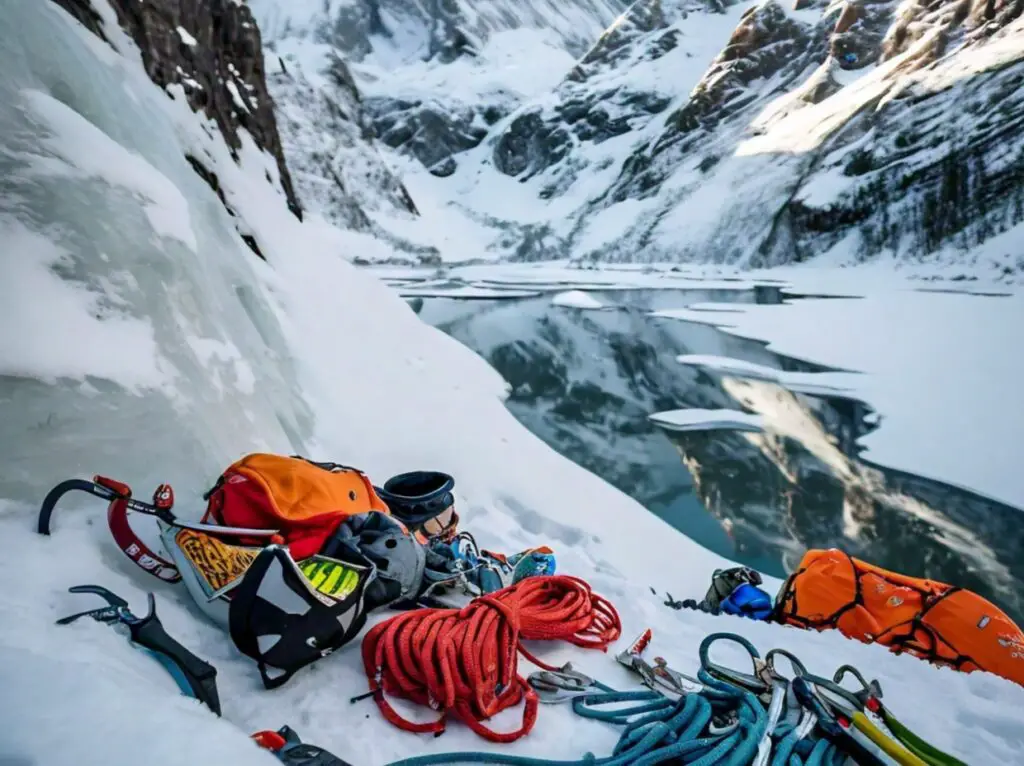
What Equipment is Needed for Ice Climbing?
Ice climbing is a thrilling and challenging sport where climbers ascend frozen waterfalls, ice-covered rocks, and ice formations. To do this safely and effectively, having the right equipment is crucial. This article will guide you through all the necessary equipment needed for ice climbing, making it easy to understand even for 5th-grade students. We’ll explore each piece of equipment in detail, ensuring you’re well-prepared for your icy adventures.
Key Takeaways
- Ice climbing requires specialized equipment for safety and efficiency.
- Understanding each piece of equipment and its purpose is essential.
- Proper gear ensures a successful and enjoyable ice climbing experience.
Basic Equipment for Ice Climbing
1. Ice Axes
Ice axes are essential tools for ice climbing. They help climbers grip the ice and pull themselves upward. There are two main types of ice axes: technical ice axes and mountaineering axes. Technical ice axes are designed for steep ice and mixed climbing, while mountaineering axes are better for general ice climbing and alpine climbing.
Quote: “Ice axes are like an extension of your hands, giving you the power to grip and climb the ice with ease.”
2. Crampons
Crampons are spiked devices attached to your boots to provide traction on ice. They have sharp points that dig into the ice, preventing slips and falls. There are different types of crampons, including step-in, strap-on, and hybrid crampons, each designed for specific types of ice climbing.
Quote: “Crampons turn your feet into claws, helping you grip the ice and stay secure.”
3. Climbing Harness
A climbing harness is a vital piece of safety equipment that connects you to the climbing rope. It fits around your waist and legs, providing support and security. The harness allows you to attach other equipment like carabiners, ice screws, and quickdraws.
Quote: “A climbing harness is like a seatbelt, keeping you safe and secure while you climb.”
4. Climbing Rope
Climbing ropes are specially designed for ice climbing, offering strength and flexibility. They are usually dynamic ropes, meaning they can stretch slightly to absorb the impact of a fall. Ropes come in various lengths and thicknesses, depending on the type of climbing and the number of climbers.
Quote: “The climbing rope is your lifeline, providing a safety net as you ascend the ice.”
5. Ice Screws
Ice screws are used to anchor the climbing rope to the ice. They are threaded tubes with sharp points that can be screwed into the ice, creating secure attachment points. Ice screws are crucial for setting up protection and belay stations during your climb.
Quote: “Ice screws are your anchors, keeping you secure as you climb higher.”
6. Carabiners and Quickdraws
Carabiners are metal loops with spring-loaded gates used to connect various pieces of climbing equipment. Quickdraws are pairs of carabiners connected by a short piece of webbing. They are used to attach the rope to the ice screws, providing a flexible connection that allows the rope to move smoothly.
Quote: “Carabiners and quickdraws are the connectors that link your gear together, ensuring a smooth and safe climb.”
7. Helmet
A helmet is essential for protecting your head from falling ice and other debris. It should fit snugly and be comfortable to wear. Helmets designed for ice climbing are lightweight and have ventilation to keep you cool.
Quote: “A helmet is your shield, guarding your head from any dangers above.”
8. Ice Climbing Boots
Ice climbing boots are specially designed to keep your feet warm and dry while providing support and stability. They are stiff to accommodate crampons and offer good insulation against the cold.
Quote: “Ice climbing boots are your foundation, giving you the support and warmth needed for a successful climb.”
9. Gloves
Gloves are crucial for keeping your hands warm and protected. They should be waterproof, insulated, and provide a good grip. Many climbers carry multiple pairs of gloves to change if they get wet.
Quote: “Gloves are your shield against the cold, keeping your hands warm and nimble.”

Advanced Equipment for Ice Climbing
10. Ice Tool Leashes and Hand Rest
Ice tool leashes help secure your ice axes to your wrists, preventing them from falling if you lose your grip. Hand rests on ice axes provide additional support and comfort, reducing hand fatigue during long climbs.
Quote: “Leashes and hand rests are your helpers, giving you extra security and comfort on the ice.”
11. Belay Device
A belay device is used to control the climbing rope, allowing the belayer to manage the rope’s tension and catch the climber if they fall. There are various types of belay devices, including tubular and assisted-braking devices.
Quote: “The belay device is your control center, managing the rope and ensuring safety for both climber and belayer.”
12. Avalanche Safety Gear
In some ice climbing areas, avalanches can be a risk. Avalanche safety gear includes a beacon, probe, and shovel. These tools are essential for locating and rescuing climbers in the event of an avalanche.
Quote: “Avalanche safety gear is your lifeline in dangerous conditions, providing essential tools for rescue.”
13. Backpack
A backpack is necessary for carrying all your gear to and from the climbing site. It should be spacious, durable, and comfortable to wear. Look for a backpack with compartments for organizing your equipment and easy access to your gear.
Quote: “A backpack is your trusty carrier, holding all your essential gear and keeping it organized.”
Clothing for Ice Climbing
14. Base Layers
Base layers are the first layer of clothing worn next to your skin. They should be moisture-wicking and insulating, keeping you dry and warm. Materials like merino wool or synthetic fabrics are ideal for base layers.
Quote: “Base layers are your first defense against the cold, keeping you warm and dry from the inside out.”
15. Mid Layers
Mid layers provide additional insulation and warmth. Fleece jackets, down jackets, or synthetic insulated jackets are common choices for mid layers. They help trap heat and keep your body warm in cold conditions.
Quote: “Mid layers are your warmth boosters, adding extra insulation to keep the cold at bay.”
16. Outer Layers
Outer layers protect you from wind, snow, and ice. These include waterproof and windproof jackets and pants. Look for outer layers with good breathability and ventilation to prevent overheating.
Quote: “Outer layers are your shield against the elements, keeping you dry and protected.”
17. Socks
Socks should be warm, moisture-wicking, and provide good cushioning. Wool or synthetic blend socks are excellent choices for ice climbing. Avoid cotton socks as they can retain moisture and lead to cold feet.
Quote: “Socks are your foot protectors, keeping your feet warm, dry, and comfortable.”
Additional Accessories for Ice Climbing
18. Gaiters
Gaiters are worn over your boots and lower legs to prevent snow and ice from entering your boots. They provide an additional layer of protection and help keep your feet dry.
Quote: “Gaiters are your snow guards, keeping the cold and wet out of your boots.”
19. Headlamp
A headlamp is essential for climbing in low light conditions. It frees up your hands and provides illumination for navigating and climbing in the dark.
Quote: “A headlamp is your guiding light, illuminating the way in the dark.”
20. Sunglasses or Goggles
Sunglasses or goggles protect your eyes from the bright glare of the sun on the ice and snow. They also shield your eyes from wind and ice particles.
Quote: “Sunglasses and goggles are your eye protectors, guarding against glare and debris.”
21. Hydration System
Staying hydrated is crucial, even in cold conditions. A hydration system like a water bottle or hydration bladder helps you drink water easily without having to stop and take off your backpack.
Quote: “A hydration system is your thirst quencher, keeping you hydrated and energized.”
22. Snacks and Energy Bars
Carrying snacks and energy bars provides quick and easy nourishment during your climb. Choose high-energy foods that are easy to eat on the go, like nuts, dried fruit, and energy gels.
Quote: “Snacks and energy bars are your fuel, giving you the energy to keep climbing.”
23. First Aid Kit
A first aid kit is essential for treating minor injuries and emergencies. It should include bandages, antiseptic wipes, pain relievers, and any personal medications.
Quote: “A first aid kit is your emergency helper, ready to treat injuries and keep you safe.”
Preparing for Your Ice Climbing Adventure
24. Training and Skills
Before heading out, it’s important to have the necessary training and skills for ice climbing. This includes knowing how to use your equipment, understanding climbing techniques, and being aware of safety protocols.
Quote: “Training and skills are your foundation, ensuring you are prepared and confident on the ice.”
25. Weather and Conditions
Always check the weather and conditions before your climb. Ice conditions can change rapidly, and it’s important to be aware of any potential hazards.